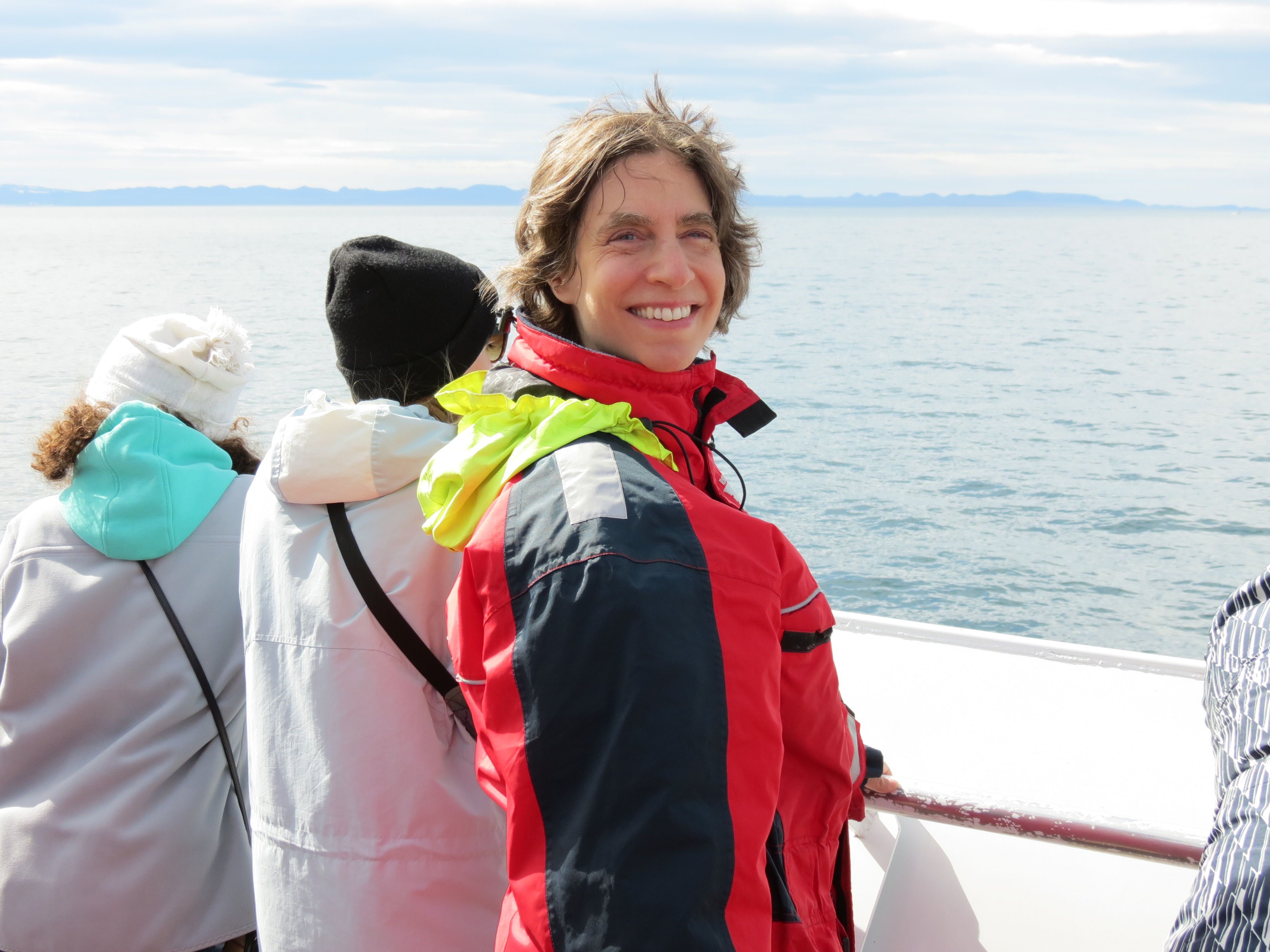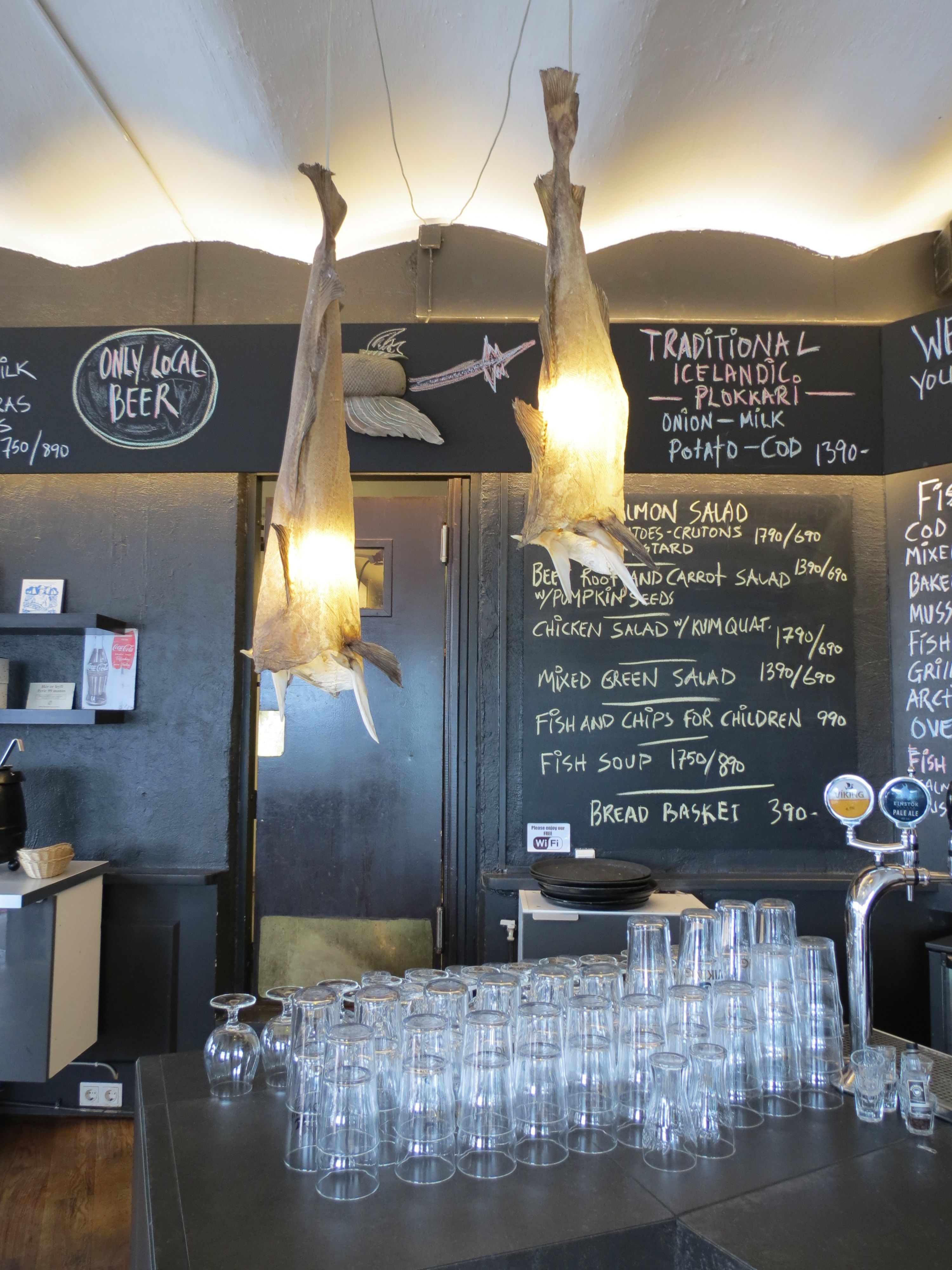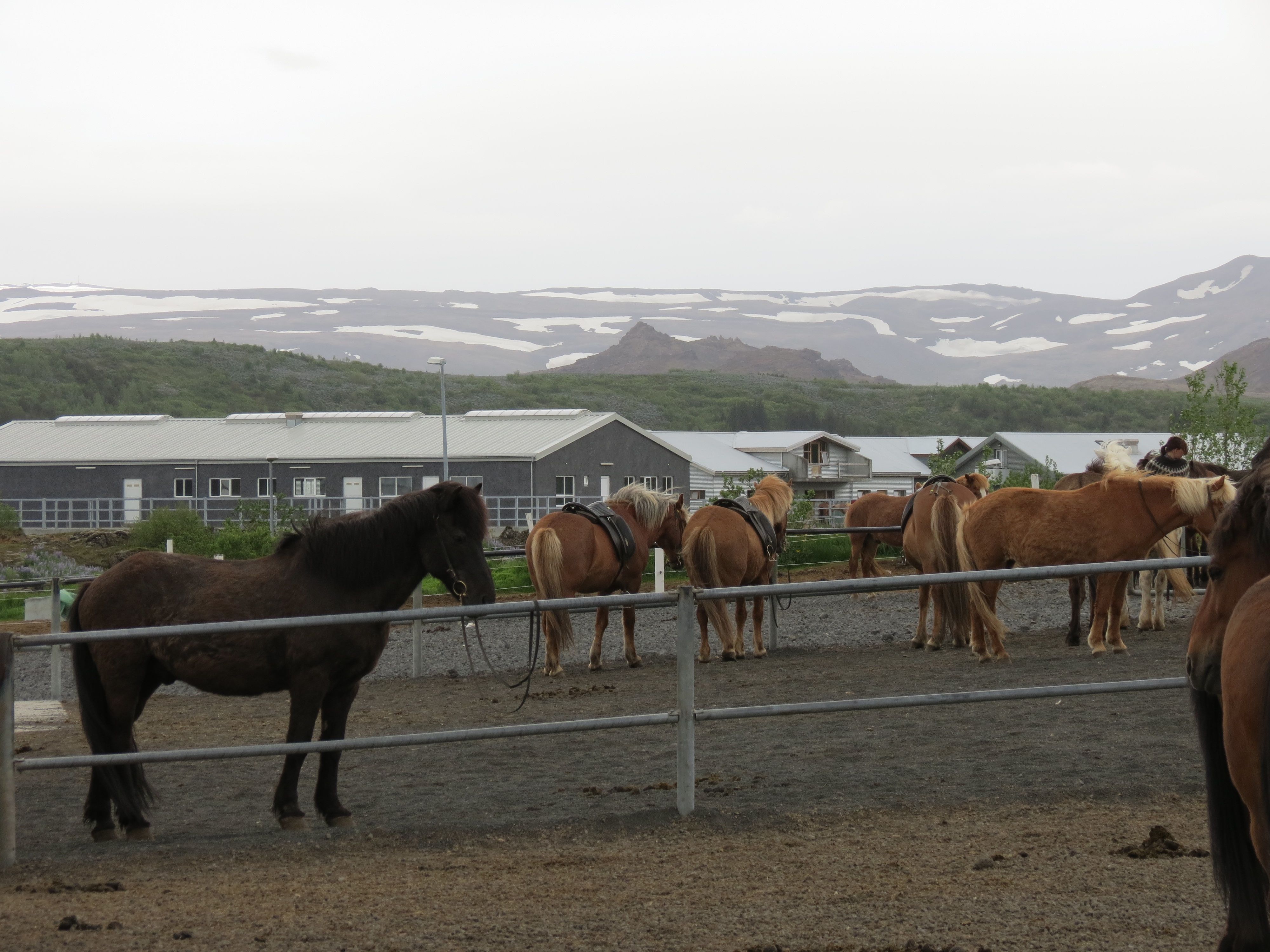
|
–Geoff-Hart.com: Editing, Writing, and Translation —Home —Services —Books —Articles —Resources —Fiction —Contact me —Français |
by Geoff Hart
Previous installment: June 27 on the Reykjanes peninsula
Today was our first completely free day, and we decided before coming that we’d use it for whale watching and horse riding. We booked a combined package with Elding tours that would take us out into Reykjavic Bay for 3 hours in search of cetaceans, followed by a shuttle into the countryside and a couple hours riding Icelandic horses.
Weather was lovely for whale watching, with blue skies and sun, and beautiful scenery on all sides of the wide bay, including a view of far-distant Snaefelljökul (snae = snow, fell = mountain, jökul = glacier). The sun sparkled off the water, clouds flitted by overhead in a range of shapes, and a pleasant but often strong breeze blew. Pleasant, of course, by my standards. Shoshanna and most of the other passengers donned red full-body coveralls that were impenetrable to the wind, lined with polar fleece, and stuffed with enough flotation gear that it wasn’t necessary to don a lifejacket. Had I worn one, I’d have melted down into a small, smelly puddle, and that not being a desirable outcome, I decided to stick with my Goretex jacket and a thin shirt under it. Worked a treat. No waves to speak of, though the tour company had a bowl of anti-seasickness pills downstairs (“just in case”), by the bar, where they were being handed out like mints at a restaurant.
Here's Shoshanna in her très chic nautical wear:

We were still early in the season, so not much in the way of whale action. There was a small but significant chance we’d see humpback whales, and a near-zero but non-zero chance of seeing a blue whale, and indeed, we saw neither. But we did see many white-nosed dolphins, arcing in and out of the waves in eerily perfect synchrony, and one even left the water entirely, landing with a smack on his side. We also saw minke whales half a dozen times, but they’re much more shy; about all you see is a 10-foot stretch of back and the dorsal fin, and if you get to close, they dive deep and you won’t see them again for 10 or more minutes. (Deep is relative; in this bay, the water is rarely more than 30 m deep.) We came within about 100 feet of the dolphins several times, so got a good view but the whales remained at least twic that distance away, and because Elding is a whale-friendly organization, they didn’t chase down the animals so we could get closer. No photos, because their appearances were too random and at too great a distance to be worth the effort of trying to snatch a shot.
The star performers were the puffins, of which we saw a great many bobbing amidst the waves. They wouldn’t let the boat come too close, and shot off as soon as it looked like we might come near (Icelanders eat them, so there’s some reason for this), but they’re remarkably heavy and clumsy fliers; they make brown pelicans look graceful. Shoshanna’s description of their escape mode is pretty good: like skipping stones flung along the surface and skipping off the wavetops. It looked like they were running along the surface of the water and flying only enough to avoid face-planting in a wave.
Not tremendously exciting on the whole, but a pleasant day on the water nonetheless and some nice dolphin action. We arrived back at dock around noon, with enough time to run up the street and get some excellent fish and chips (cod, I believe). Amusingly, the counter in the restaurant had two lamps made from dried skins of cod. (The heads, of course, were missing, having been shipped off to Africa to end their existence as soup.) Cod lanterns:

We took the food back to the dock and savored it, whilst people-watching. Not long after we were done, the shuttle came to fetch us to the horse riding place. This was off in the wilds of the Reykjanes peninsula, but only about half an hour out of town. A very different area from any we’d see before, since there’d been much reforestation going on, and there were actual significant stands of trees -- not quite full-blown forest, but heading leisurely in that direction. Mostly planted pines (possibly lodgepole pine?), spruce (black spruce?), and some rowan, with a great many birch and willow shrubs starting to take hold. Interestingly, though there are still carpets of arctic lupen in many places, this menace to the indigenous biota didn’t seem to have invaded under the trees or bushes. This gives me hope that as the trees proliferate, they’ll shade out the lupens. I also suspect that as the soils begin to mature beneath the trees, and as soil fertility begins to increase, the lupens will gradually disappear, like all early-successional species eventually do, leaving room for a mixture of the native vegetation and the imported trees. Here's a typical landscape where we rode, framed by the horses:

The only sour note is that many of the pines are showing rust symptoms, with fiery-orange dead needles. I snatched a few of them from trees later in the day, during our ride, to see whether there were any obvious symptoms of disease. Nothing obvious like the lesions caused by a typical rust fungus (which commonly causes this kind of symptom), so it might just be a nutrient deficiency caused by the immature soils or perhaps salt damage, since the onshore breeze would carry a lot of salt spray this far inland. Or they may have just imported a narrow sample of genotypes that weren’t particularly well suited to Iceland’s climate.
Icelandic horses are a unique bloodline that (according to our hosts) have never been bred with other horse lines, so they’re as pureblooded as anything bred by humans can be. They’re smaller than the typical riding horse you’d see at a North American dude ranch, but larger than ponies. And they’re very pretty, even if you don’t much like horses. They have charismatic, placid faces, and come in a wide range of colors and patterns. Our hosts at the Is Hestar (“ice horses”) stables ran an introductory video about horsemanship 101. Nothing I hadn’t heard before, but still a useful reminder, since it’s been 20+ years since the last time I sat on a horse. Still, like riding a bike... I got into the saddle nimbly enough, and had no problem staying there during the ride.
Each of us was equipped with a riding helmet (non-negotiable) and rubber wellies (optional, but more suitable for riding than the hiking boots most of us were wearing). They also offered rain gear, but I was happy enough with my goretex and hiking pants. We had a few spatters of rain along the way, but nothing unpleasant.
The introductory brochure they gave us suggested that the horse’s weight capacity tops out at about 240 pounds, which is comfortably enough for me, but significantly less than a typical cowboy-style Western horse. Still, my faithful steed to be (“Tango”) gave me a skeptical look; clearly he was hoping for an easier burden, as it was near the end of the day and he was clearly enjoying doing nothing more strenuous than chilling with his buds. I introduced myself to him, letting him sniff my hand, then stroking his nose, and he was quite happy thereafter. They seem to be very placid horses, with none of the nipping and kicking that North American dude ranch horses so often engage in. They’re perfectly happy to ride nose to tail and leave the driving to the lead horse, though some clearly had preferred positions in the line and didn’t want anyone usurping those positions. One horse in front of me kept stopping to snatch a snack, and as soon as I moved around him, he’d lurch forward to regain his position.
Like all dude ranch horses, Tango was used to inexperienced riders, and clearly wanted to see what he could get away with. I didn’t let him get away with much of anything; I know how to keep a horse firmly in hand without harming it, so after a bit of negotiation, he settled down and let me guide him where I wanted. Many others were less firm, so their horses took full advantage, periodically leaving the trail to snatch a snack. (Dandelions seemed particularly popular, with a couple horses riding about like a gypsy dancer with a rose in her teeth.) Here's me showing my horsely chops (also to prove I was actually in Iceland rather than just making up this whole story from a Montreal Internet café):
The main new thing about these horses was that when you ride Icelandic horses, you don’t “post” (bounce up and down to damp the motion of the horse) like you do with Western horses: you just sit back in the saddle (very similar to an English riding saddle) and move with the horse. This is because they have a weird gait in addition to the familiar walk, trot, canter, and gallop of Western horses, and it mostly replaces the trot: it’s called “tölt” (pronounced sort of like “tuhlssh” if I heard the guide right), and involves a high-stepping, almost prancing motion. It’s much smoother than a trot (no bouncing or jolting), and feels almost like a canter, except for the unusual footwork. Tango was tired and didn’t much like moving at that speed, so we ended up trotting more than tölting. One of the guides showed us how tölting is done, and it clearly scales well, from a fast walk right up to a reasonable fast cantering pace. One of our hosts joked that it was bred into the horses so that you wouldn’t have to worry about spilling your beer while you rode. This, in the fiction biz, is what we call “dramatic foreshadowing”.
Being a fiction writer, I asked the senior guide about the endurance of these horses. Many writers treat horses like cars: get in and drive without stopping to reach your destination. I know that’s wrong, but wanted some more concrete guidance. The guide told me that they tend to ride their horses no more than about 6 hours per day, with breaks every hour and walking the horses without a rider in between. I asked about distance, proposing 20 km, and she said that would be a heavy day for these horses. Larger horses can probably go farther, but it’s worth keeping this distance in mind if you’re writing horse operas.
We had a pleasant ride through the country. Like all dude ranch horses the world over, these ones knew where we were going and when, and largely just followed peacefully along in a line. In a few places, we shared the road with cars, and most of the drivers were well behaved: they stopped and waited for the horses to pass. One of them didn’t, and our lead guide cursed him out loud enough to be heard down the line where I was riding. I didn’t quite muster the courage to ask her to teach me those particular Icelandic terms.
The aforementioned foreshadowing was fulfilled when we decided to buy a “Viking” brand beer to bring back to the hotel for afterwards. The woman behind the bar started to open it, and I stopped her, because the shuttle would be leaving shortly, and I didn’t think we’d have time to drink it before leaving or that we’d be allowed to drink it on the shuttle. Unfortunately, though the cap seemed intact, she must have opened the cap slightly before I stopped her, and most of the beer escaped in Shoshanna’s backpack. Made quite a mess, and cost Shoshanna a couple hours washing and drying the stuff in the pack once we got back to the room.
Dinner was at Askur, a local restaurant in the Hilton Hotel complex. Dick had recommended it, and it was OK, but it’s primary merit was that it was an easy walk from our hotel. I had a decent grilled salmon (nice and juicy), and Shoshann had a passable but unremarkable white-fleshed “redfish”, both accompanied by an adequate but not exceptional salad bar. I had a pint of the Viking beer, and it was decent but not particulalry characterful; the Gull we tried early on is probably a bit better in that genre of beer. I think the main attraction to this place other than its proximity to the hotel is that they have an all-you-can-eat meat buffet for those with Viking appetites, and the price is quite reasonable by Iceland restaurant standards (about C$45). Neither of us was that hungry, so we didn’t choose the option. Nothing wrong with the place, but if we’d been more energetic at the end of a long day, we’d probably have walked into town (half an hour or so each way) in search of something more interesting, and probably will do so next time, since our last night in Iceland will be at the same hotel.Next installment: June 29th in rift valleys, near waterfalls, and in greenhouses
©2004–2024 Geoffrey Hart. All rights reserved.